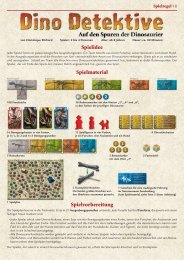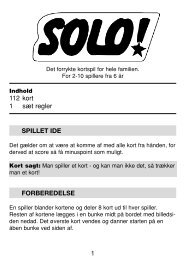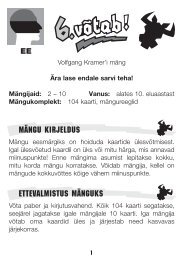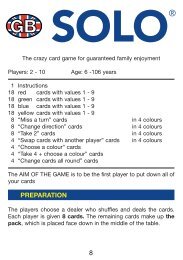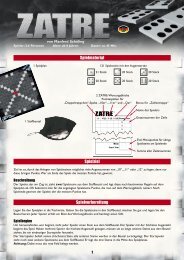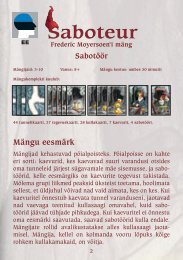Cliffhanger mlv a13:layout 1 - AMIGO Spiel + Freizeit Gmbh
Cliffhanger mlv a13:layout 1 - AMIGO Spiel + Freizeit Gmbh
Cliffhanger mlv a13:layout 1 - AMIGO Spiel + Freizeit Gmbh
Create successful ePaper yourself
Turn your PDF publications into a flip-book with our unique Google optimized e-Paper software.
Günter Burkhardt<br />
INHALT<br />
<strong>Spiel</strong>er: 3 - 6<br />
Alter: ab 8 Jahren<br />
Dauer: 15 Minuten<br />
50 Ziegen-Karten mit Rückseite<br />
1 – 5 Ziegensymbolen<br />
12 Hügelkarten (Werte 1 – 8) Rückseite<br />
1 Holz-Ziege<br />
1
2<br />
SPIELIDEE & SPIELZIEL<br />
Die <strong>Spiel</strong>er kriegen in acht „Stichen“ jede Menge Ziegen,<br />
die auf den Karten als schwarze Ziegenköpfe zu<br />
sehen sind.<br />
Außerdem wird im Laufe des <strong>Spiel</strong>s in der Tischmitte<br />
ein Hügel zu sam men gelegt, der das Ziegen-Limit für<br />
das <strong>Spiel</strong>ende festlegt. Wer bei <strong>Spiel</strong> ende mehr Ziegen<br />
auf seinen Karten besitzt als das Limit vorgibt,<br />
kann nicht gewinnen. Denn Sieger wird, wer am<br />
meisten Ziegen ge kriegt hat, ohne das Limit zu überschreiten!<br />
SPIELVORBEREITUNG<br />
Die Ziegen-Karten werden gut gemischt. Jeder <strong>Spiel</strong>er<br />
kriegt – unabhängig von der <strong>Spiel</strong>erzahl – 8 Karten<br />
verdeckt auf die Hand. Die restlichen Karten<br />
werden in die Schachtel zurückgelegt.<br />
Die gut gemischten Hügelkarten werden als verdeckter<br />
Stapel auf den Tisch gelegt. Die Ziege steht<br />
neben dem Hügelkarten-Stapel bereit.<br />
SPIELABLAUF<br />
Der jüngste <strong>Spiel</strong>er ist Startspieler.<br />
Reihum im Uhrzeigersinn spielt jeder <strong>Spiel</strong>er eine<br />
Karte offen aus. Die aus gespielten Karten – eine von<br />
jedem <strong>Spiel</strong>er – nennt man „Stich“.<br />
Der <strong>Spiel</strong>er mit der niedrigsten gespielten Karte im jeweiligen<br />
Stich darf eine Hügelkarte auf decken und in<br />
die Tischmitte legen. Er be stimmt durch das Legen der<br />
Hügelkarte und das Setzen der Holz-Ziege, mit wel-
cher der beiden Zah len der Hügel gebildet werden soll.<br />
Der <strong>Spiel</strong>er mit der höchsten gespielten Karte kriegt<br />
den Stich und legt die gewonnenen Karten verdeckt<br />
vor sich ab. Er eröffnet den nächs ten Stich. Abgelegte<br />
Karten dürfen nicht mehr angeschaut werden.<br />
Nur nach dem ersten, zweiten, dritten und vierten<br />
Stich wird eine Hü gel karte gelegt. Die restlichen Stiche<br />
werden gespielt, ohne dass weitere Hügelkarten<br />
ins <strong>Spiel</strong> kommen.<br />
Bei der ersten Hügelkarte stellt der <strong>Spiel</strong>er die Ziege<br />
auf die gewählte Zahl. Die zweite, dritte und vierte<br />
Hügelkarte müssen jeweils rechtwinklig an eine ausliegende<br />
Hügelkarte angelegt werden (siehe Bei spiel<br />
auf der nächsten Seite).<br />
Die zweite Hügelkarte muss der <strong>Spiel</strong>er an das Hügelteil<br />
mit der Holz-Ziege anlegen. Er kann aussuchen,<br />
welchen Teil der zweiten Karte er an die<br />
Holz-Ziege legt. Im Beispiel kann er das 3-er-Hügel teil<br />
oder das 7-er-Hügelteil an die erste Hügelkarte anlegen<br />
und damit die Ziegen an zahl auf dem Hügel entweder<br />
auf 7 Ziegen oder auf 11 Ziegen erhöhen.<br />
Die Ziege wird danach so auf den Hügel gestellt, dass<br />
sie keine Zahl verdeckt.<br />
Dann können die <strong>Spiel</strong>er<br />
die Gesamtsumme des Hügels<br />
jederzeit erkennen.<br />
3
4<br />
Beispiel:<br />
1. Hügelkarte<br />
2. Hügelkarte<br />
1.<br />
2.<br />
2 Möglichkeiten:<br />
Summe 7 (4 + 3)<br />
Summe 11 (4 + 7)<br />
Mit der dritten Hügelkarte wird der Hügel aus der<br />
ersten und zweiten Hügelkarte weiter vergrößert.<br />
Die vierte Hügelkarte schließt den Hü gel ab.<br />
So entsteht ein Hügel aus 4 Karten, der bestimmt,<br />
wie viele Ziegen köpfe die <strong>Spiel</strong>er in ihren Karten bei<br />
<strong>Spiel</strong>ende maximal haben dürfen.<br />
SPIELENDE<br />
Das <strong>Spiel</strong> endet nach dem achten Stich.<br />
Jeder <strong>Spiel</strong>er zählt die Ziegen-Köpfe auf den Karten<br />
seiner Stiche zu sam men (siehe Beispiel). Liegt die
Summe über dem Ziegen-Limit, kann der <strong>Spiel</strong>er<br />
nicht gewinnen.<br />
Sieger ist der <strong>Spiel</strong>er mit den meisten Ziegenköpfen,<br />
der das Limit nicht überschreitet. Bei Punktegleichstand<br />
gibt es mehrere Sieger. Auch ein <strong>Spiel</strong>er, der<br />
keine Ziege gekriegt hat, ge winnt, falls al le anderen<br />
<strong>Spiel</strong>er über dem Limit sind. Enden alle <strong>Spiel</strong>er über<br />
dem Li mit, gibt es keinen Sieger.<br />
Beispiel zur Endabrechnung:<br />
1 + 2 + 3 + 5 + 2 + 1 + 1 + 3<br />
= 18 Ziegen-Köpfe<br />
Ziegen-Limit: 17 (4 + 7 + 5 +1)<br />
Marion hat 18 Ziegen-Köpfe,<br />
Hubi hat 17 Ziegen-Köpfe,<br />
Dennis hat 12 Ziegen-Köpfe<br />
Philippa hat 4 Ziegen-Köpfe.<br />
Marion scheidet aus, da sie<br />
mehr Ziegenköpfe als das<br />
Limit hat.<br />
Hubi gewinnt, da er von den<br />
<strong>Spiel</strong>ern, die nicht über dem<br />
Limit sind, am meisten Ziegenköpfe<br />
hat.<br />
5
6<br />
Alternativ können auch so viele Runden gespielt werden,<br />
wie <strong>Spiel</strong>er teilnehmen. Die <strong>Spiel</strong>er erhalten<br />
dann nach jedem <strong>Spiel</strong> so viele Punkte, wie sie Ziegenköpfe<br />
gekriegt haben, und notieren sie auf<br />
einem Blatt. Wer über dem Limit liegt, erhält für die<br />
Partie 0 Punkte. <strong>Spiel</strong>er ohne Stich erhalten Punkte<br />
in Höhe der Zahl, auf der die Holz -Ziege stand. Wer<br />
nach der festgelegten Rundenzahl am meisten Punk -<br />
te hat, ge winnt.<br />
Sie haben ein Qualitätsprodukt gekauft. Sollten Sie dennoch Anlaß zu einer<br />
Reklamation haben, wenden Sie sich bitte direkt an uns.<br />
Haben Sie noch Fragen? Wir helfen Ihnen gerne:<br />
<strong>AMIGO</strong> <strong>Spiel</strong> + <strong>Freizeit</strong> GmbH, Waldstraße 23-D5, D-63128 Dietzenbach<br />
www.amigo-spiele.de, E-Mail: redaktion@amigo-spiele.de<br />
© <strong>AMIGO</strong> <strong>Spiel</strong> + <strong>Freizeit</strong> GmbH, D-63128 Dietzenbach, MMVIII Version 1.0
Günter Burkhardt<br />
1 wooden Goat<br />
Counter<br />
CONTENTS<br />
For 3 to 6 Players<br />
Ages 8 and up<br />
Duration: approx. 15<br />
minutes<br />
50 Goat Cards with Back<br />
1 to 5 Goat Heads each<br />
12 Hill Cards (values 1 to 8) Back<br />
7
8<br />
GAMEPLAY AND GOALS:<br />
Players take tricks and collect plenty of Goats, in the<br />
form of the black Goat Head symbols showing on<br />
their cards.<br />
In the middle of the table, the Hill is constructed at<br />
the same time, determining the Goat Limit for the<br />
end of the game. Players who by the end of the game<br />
have collected more Goats than the limit allows, cannot<br />
win the game. However, if you have managed to<br />
gather the most Goats and to stay within the limit,<br />
you are the winner!<br />
PREPARATION:<br />
Shuffle the Goat Cards thoroughly. Each player is<br />
dealt a hand of 8 cards, which must not be shown to<br />
the other players. The number of dealt cards does not<br />
depend on the number of players. All remaining<br />
Goat Cards are put back into the box.<br />
The Hill Cards are also shuffled and placed face down<br />
in a pile in the middle of the table. The Goat Counter<br />
is put next to the Hill Card pile.<br />
PLAYING SEQUENCE:<br />
The youngest player goes first. All other players take<br />
their turns clockwise.<br />
Each player plays one card face up. These played<br />
cards – one from each player – are called a “trick”.<br />
The player who has played the card with the lowest<br />
value in a trick takes a Hill Card from the pile and places<br />
it face up in the middle of the table. He or she de-
termines, which of the two values shown on the card<br />
is being used for this game by placing the card next<br />
to another one and/or putting the Goat Counter on<br />
the corresponding value.<br />
The player who has played the card with the highest<br />
value takes the trick and places the cards he or she<br />
has won in a face-down pile in front of him- or herself.<br />
The cards in this pile must not be looked at<br />
again. The player taking the trick also goes first in<br />
the next trick.<br />
Hill Cards are only turned over after the first, second,<br />
third and fourth trick. All other tricks are played with -<br />
out cards being added to the Hill.<br />
When the first Hill Card is revealed, the player puts<br />
the Goat Counter on the value of his or her choice.<br />
The second, third, and fourth Hill Cards must be<br />
placed next to the first one at a right angle (see<br />
example on the back).<br />
The second Hill Card must be placed next to the part<br />
of the Hill with the Goat Counter. The player may<br />
choose him- or herself which part of the second card<br />
is to be put next to the Goat. In the example, the<br />
player may decide to use the Hill part bearing the<br />
value 3 or the one with the 7, thus increasing the<br />
total number of Goats on the Hill to either 7 or 11.<br />
The Goat is then placed on the Hill<br />
so that it doesn’t obscure any of<br />
the numbers, so that players are always<br />
aware of the total value of<br />
the Hill.<br />
9
10<br />
Example:<br />
1st Hill Card<br />
2nd Hill Card<br />
1.<br />
2.<br />
2 possibilities<br />
Total: 7 (4+3)<br />
Total: 11 (4+7)<br />
The third Hill Card extends the Hill formed by the first<br />
and second card. The fourth Hill Card completes the<br />
Hill.<br />
The Hill then finally consists of four cards, which<br />
determine the maximum number of Goat Heads each<br />
player may possess by the end of the game.<br />
END OF THE GAME:<br />
The game ends after the 8th trick is taken.<br />
Each player then adds up the number of Goat Heads<br />
in his or her tricks (see example). If the total exceeds
the Goat Limit, this player cannot win. The player<br />
who has collected the most Goat Heads while staying<br />
within the limit wins the game. If two or more<br />
players have collected the same highest number of<br />
Goat Heads, there may be more than one winner. A<br />
player who has avoided collecting any Goats at all<br />
may win the game, if all other players have exceeded<br />
the limit. If all players exceed the limit, there is no<br />
winner.<br />
Example for the final score:<br />
1 + 2 + 3 + 5 + 2 + 1 + 1 + 3<br />
= 18 Goat Heads<br />
Goat Limit: 17 (4 + 7 + 5 +1)<br />
Marion has collected 18 Goat<br />
Heads. Henry has collected<br />
17 Goat Heads. Dennis has<br />
collected 12 Goat Heads. Philippa<br />
has collected 4 Goat<br />
Heads. Marion loses, because<br />
her number of Goat Heads<br />
exceeds the limit.<br />
The winner is Henry, because<br />
he has collected the highest<br />
number of Goat Heads of all<br />
players who have stayed<br />
with in the limit.<br />
11
12<br />
Players may also choose to play as many rounds as<br />
there are players in the game. After each round, the<br />
number of Goat Heads they have collected is noted<br />
down on a piece of paper. Players who have exceeded<br />
the limit of the round get 0 points. Players who have<br />
taken no tricks in a round get a number of points<br />
equal to the number on which the Goat Counter sits.<br />
The player with the highest score after the pre-agreed<br />
number of rounds has been played wins the game.<br />
If you have comments, questions, or suggestions, please contact us:<br />
<strong>AMIGO</strong> <strong>Spiel</strong> + <strong>Freizeit</strong> GmbH, Waldstraße 23-D5, D-63128 Dietzenbach<br />
www.amigo-spiele.de, E-Mail: redaktion@amigo-spiele.de<br />
© <strong>AMIGO</strong> <strong>Spiel</strong> + <strong>Freizeit</strong> GmbH, D-63128 Dietzenbach, MMVIII Version 1.0
Günter Burkhardt<br />
1 chèvre en bois<br />
CONTENU<br />
Nombre de joueurs :<br />
3 – 6<br />
Age : dès 8 ans<br />
Durée :<br />
env. 15 minutes<br />
50 cartes Chèvre avec verso<br />
1 – 5 symboles de chèvre<br />
12 cartes Colline (de valeur 1 – 8) verso<br />
13
14<br />
BUT DU JEU<br />
En huit levées, les joueurs reçoivent une certaine<br />
quantité de chèvres représentées par des têtes noires<br />
sur les cartes.<br />
Au cours du jeu, une colline est assemblée au milieu<br />
de la table, elle va fixer le nombre limite de chèvres<br />
pour la fin de la partie. Au terme du jeu, le joueur<br />
qui possède plus de chèvres sur ses cartes que la limite<br />
autorisée ne peut pas gagner. Le vainqueur est<br />
celui qui a récolté le plus de points sans dépasser<br />
cette limite.<br />
PRÉPARATION D’UNE PARTIE<br />
Les cartes Chèvre sont bien mélangées. Chaque<br />
joueur reçoit 8 cartes – indépendamment du nombre<br />
de joueurs – qu’il ne montre pas aux autres. Les cartes<br />
restantes sont rangées dans la boîte.<br />
Les cartes Colline sont bien mélangées, puis empilées<br />
sur la table, face cachée. La chèvre en bois est posée<br />
à côté de cette pioche.<br />
DÉROULEMENT DU JEU<br />
Le joueur le plus jeune commence.<br />
A tour de rôle, dans le sens des aiguilles d’une montre,<br />
les joueurs posent une carte, face visible. L’ensemble<br />
de ces cartes – une par joueur – est la levée.<br />
Le joueur ayant posé la carte la plus faible dans chaque<br />
levée, peut retourner une carte Colline et la<br />
placer au milieu de la table. Il décide, en posant la<br />
chèvre en bois sur la carte Colline, avec quel chif-
fre, parmi les deux qui y figurent, la colline va être<br />
formée.<br />
Le joueur ayant déposé la carte la plus forte, doit<br />
prendre la levée et la placer, face cachée, devant lui.<br />
C’est à son tour de débuter la prochaine levée. Les<br />
cartes récoltées ne peuvent plus être consultées.<br />
Les cartes Colline sont placées uniquement à la première,<br />
deuxième, troisième et quatrième levée. Les<br />
levées suivantes sont jouées sans poser d’autres cartes<br />
Colline.<br />
Lorsque le joueur pose la première carte Colline, il<br />
met la chèvre en bois sur le chiffre choisi. Ensuite, les<br />
deuxième, troisième et quatrième cartes doivent être<br />
placées à angle droit par rapport à une autre carte<br />
Colline (voir exemple au verso).<br />
Le joueur doit poser la deuxième carte Colline à côté<br />
de la partie où se trouve la chèvre en bois. Il peut<br />
choisir quelle partie de la deuxième carte il va poser<br />
à côté de la chèvre en bois. Dans l’exemple au verso,<br />
il peut choisir soit le 3, soit le 7. Le joueur place la<br />
nouvelle carte Colline, et le nombre limite de chèvres<br />
passe à 7 ou à 11.<br />
La chèvre en bois est ensuite<br />
posée sur la colline, à<br />
un endroit où il n’y a pas de<br />
chiffre. Les joueurs peuvent<br />
ainsi calculer à tout moment<br />
le total des points de<br />
la colline.<br />
15
16<br />
Exemple :<br />
1 re carte Colline<br />
2 e carte Colline<br />
1.<br />
2.<br />
2 possibilités :<br />
total 7 (4 + 3)<br />
total 11 (4 + 7)<br />
La troisième carte Colline vient agrandir la colline des<br />
première et deuxième cartes. La quatrième carte Colline<br />
ferme la colline.<br />
On a alors une colline composée de 4 cartes qui déterminent<br />
la limite maximale des têtes de chèvres<br />
que les joueurs doivent avoir à la fin de la partie.<br />
FIN DE LA PARTIE<br />
La partie se termine à la fin de la huitième levée.<br />
Chaque joueur compte les têtes de chèvres sur les<br />
cartes qu’il a récoltées (voir exemple). Si le total d’un
joueur dépasse la limite autorisée, il ne peut pas gagner.<br />
Le vainqueur est le joueur qui a le plus de têtes<br />
de chèvres sans toutefois dépasser la limite autorisée.<br />
En cas d’égalité, il peut y avoir plusieurs vainqueurs.<br />
Si un joueur n‘a récolté aucune tête de<br />
chèvre et que les autres joueurs ont dépassé la limite,<br />
il gagne la partie. Si tous les joueurs dépassent la limite,<br />
il n’y a pas de vainqueur.<br />
Exemple de décompte final :<br />
1 + 2 + 3 + 5 + 2 + 1 + 1 + 3<br />
= 18 têtes de chèvres<br />
Limite de chèvres : 17 (4 + 7 + 5 +1)<br />
Marion a 18 têtes de chèvres,<br />
Hubert a 17 têtes de chèvres,<br />
Denis a 12 têtes de chèvres,<br />
et Philippe a 4 têtes de<br />
chèvres.<br />
Marion est éliminée, car elle<br />
dépasse la limite.<br />
Hubert gagne, car parmi les<br />
joueurs, il est celui qui a le<br />
plus de têtes de chèvres sans<br />
dépasser la limite.<br />
17
18<br />
Variante : peuvent aussi être joués autant de tours<br />
qu’il y a de joueurs. Les joueurs calculent après chaque<br />
jeu, le nombre de points correspondant aux têtes<br />
de chèvres qu’ils ont récoltées et les notent sur une<br />
feuille. Celui qui dépasse la limite obtient 0 point<br />
pour la partie. Le joueur qui n’a aucune carte marque<br />
le nombre de points égal à celui sur lequel est<br />
placée la chèvre en bois. A la fin des tours, celui qui<br />
a le plus de points est le vainqueur.<br />
Avez-vous des questions?<br />
Contactez-nous, nous vous aiderons volontiers:<br />
<strong>AMIGO</strong> <strong>Spiel</strong> + <strong>Freizeit</strong> GmbH, Waldstraße 23-D5, D-63128 Dietzenbach<br />
www.amigo-spiele.de, E-Mail: redaktion@amigo-spiele.de<br />
© <strong>AMIGO</strong> <strong>Spiel</strong> + <strong>Freizeit</strong> GmbH, D-63128 Dietzenbach, MMVIII Version 1.0
Günter Burkhardt<br />
1 capra di legno<br />
CONTENUTO<br />
Numero dei<br />
giocatori : da 3 a 6<br />
Età: a partire<br />
da 8 anni<br />
Durata: ca 15 minuti<br />
50 carte-capra con 1 fino a 5 simboli retro<br />
di capre sotto forma di teste di capra<br />
12 carte-collina (con valori da 1 a 8) retro<br />
19
20<br />
IDEA E SCOPO DEL GIOCO<br />
Puntando otto volte i giocatori ricevono un certo numero<br />
di capre, rappresentate sulle carte con altrettante<br />
teste nere di capre.<br />
Nel corso del gioco si crea inoltre, in mezzo al tavolo,<br />
una collina, che determina il limite massimo di capre<br />
valido per il conteggio finale del gioco. Chi alla fine del<br />
gioco possiede con le sue carte un numero di teste di<br />
capra superiore al limite massimo, non può vincere.<br />
Vince infatti chi possiede il maggior numero di capre<br />
senza tuttavia superare questo limite massimo.<br />
PREPARAZIONE AL GIOCO<br />
Le carte-capra vengono mischiate bene. Indipendentemente<br />
dal numero dei giocatori, ognuno d’essi riceve<br />
otto carte coperte in mano. Le rimanenti carte vengono<br />
riposte nella scatola.<br />
Le carte-collina vengono mischiate bene e quindi raccolte<br />
in un mazzetto coperto sul tavolo. La capra di<br />
legno viene messa vicino al mazzetto.<br />
SVOLGIMENTO DEL GIOCO<br />
Inizia il giocatore più giovane.<br />
In senso orario, ogni giocatore gioca una carta scoperta.<br />
Le carte così giocate – una da parte di ogni giocatore<br />
– si chiamano „puntata“.<br />
Il giocatore che in una puntata ha giocato la carta più<br />
bassa può scoprire una carta-collina e posizionarla al<br />
centro del tavolo. Egli determina, con il piazzare della<br />
carta-collina ed il posizionamento della capra di legno,
con quale delle due cifre deve essere formata la collina.<br />
Il giocatore che ha giocato la carta più alta guadagna<br />
la puntata e depone le carte vinte in modo coperto davanti<br />
a sé. Egli apre la prossima puntata.<br />
Le carte deposte non possono più essere visionate.<br />
Solamente dopo la prima, la seconda, la terza e la<br />
quarta puntata viene posizionata una carta-collina.<br />
Le rimanenti puntate sono giocate senza che entrino<br />
in gioco altre carte-collina.<br />
Piazzando la prima carta-collina il giocatore posiziona<br />
la capra di legno sulla cifra da lui scelta. La seconda, la<br />
terza e la quarta carta-collina deve sempre essere accostata<br />
ad angolo retto ad una delle carte-collina già<br />
posizionate (vedi esempio sul retro).<br />
La carta-collina della seconda puntata deve essere posizionata<br />
dal giocatore al lato della carta-collina già<br />
piazzata, dove si trova la capra di legno. Egli può scegliere<br />
quale lato della seconda carta mettere accanto<br />
alla capra di legno. Nell’esempio egli può piazzare la<br />
parte con 3 valori oppure quella con 7 valori accanto<br />
alla prima carta-collina ed aumentare di conseguenza<br />
il numero delle capre sulla collina a 7 rispettivamente a<br />
11 capre.<br />
La capra di legno viene poi posizionata<br />
in modo tale sulla collina<br />
da non nascondere alcuna<br />
cifra. In tal modo i giocatori<br />
possono in qualsiasi momento<br />
riconoscere il totale del valore<br />
della collina.<br />
21
22<br />
Esempio:<br />
1a carta-collina<br />
2a carta-collina<br />
1.<br />
2.<br />
2 possibilità:<br />
somma 7 (4 + 3)<br />
somma 11 (4 + 7)<br />
Con la terza carta-collina si allarga ulteriormente la collina<br />
formata dalla prima e dalla seconda carta-collina.<br />
La quarta carta-collina conclude la formazione della<br />
collina.<br />
In questo modo si forma una collina composta da 4 carte,<br />
che determina il limite massimo di teste di capra che i giocatori<br />
possono avere nelle loro carte alla fine del gioco.<br />
FINE DEL GIOCO<br />
Il gioco termina dopo l’ottava puntata.<br />
Ogni giocatore somma le teste di capra che compaiono<br />
sulle carte raccolte (vedi esempio). Se la somma oltre-
passa il limite, il giocatore non può vincere. Vince il giocatore<br />
con la maggior quantità di teste di capra, che<br />
non supera però il limite. In caso di un pareggio vi sono<br />
quindi più vincitori. Se un giocatore non ha preso alcuna<br />
testa di capra, può comunque essere il vincitore,<br />
se tutti gli altri giocatori hanno superato il limite.<br />
Quando il limite viene superato da tutti i giocatori, non<br />
esiste un vincitore.<br />
Esempio per il calcolo finale:<br />
1 + 2 + 3 + 5 + 2 + 1 + 1 + 3<br />
= 18 teste di capra<br />
Limite delle capre: 17 (4 + 7 + 5 +1)<br />
Marion ha 18 teste di capra,<br />
Hubi ha 17 teste di capra,<br />
Dennis ha 12 teste di capra,<br />
Philippa ha 4 teste di capra,<br />
Marion viene eliminata,<br />
poichè possiede più teste di<br />
capra di quanto sia il limite<br />
Hubi vince, poichè tra tutti i<br />
giocatori che non sorpassano<br />
il limite è quello che ha più<br />
teste di capra.<br />
23
24<br />
In alternativa si possono effettuare tante mani quanti<br />
sono i giocatori. In questo caso i giocatori ricevono<br />
dopo ogni puntata tanti punti quante sono le teste di<br />
capra da loro accumulate; il punteggio viene annotato<br />
su un foglio. Chi supera il limite riceve per la puntata 0<br />
punti. I giocatori senza alcuna carta ricevono tanti<br />
punti quanti sono quelli indicati sulla carta dove si trova<br />
la capra di legno. Alla fine delle puntate, vince il giocatore<br />
che ha più punti.<br />
Ha acquistato un vero prodotto di qualità. Dovesse ugualmente<br />
sussistere motivo di reclamo, può rivolgersi direttamente a noi.<br />
Volentieri risponderemo ad eventuali domande:<br />
<strong>AMIGO</strong> <strong>Spiel</strong> + <strong>Freizeit</strong> GmbH, Waldstraße 23-D5, D-63128 Dietzenbach<br />
www.amigo-spiele.de, E-Mail: redaktion@amigo-spiele.de<br />
© <strong>AMIGO</strong> <strong>Spiel</strong> + <strong>Freizeit</strong> GmbH, D-63128 Dietzenbach, MMVIII Version 1.0




